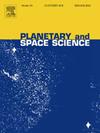一种考虑图像阴影的滑动窗口方法用于MRO HiRISE数据集的火星岩石探测
IF 1.7
4区 物理与天体物理
Q3 ASTRONOMY & ASTROPHYSICS
引用次数: 0
摘要
岩石分布是火星探测着陆点选择的关键因素。通常,火星平坦地形上的岩石具有清晰的边界和明显的阴影。我们开发了一种利用阴影(S)和滑动窗口技术(SW)从HiRISE图像中检测岩石的新方法(命名为SSW-ROCK)。SSW-ROCK使用阴影来定义光照方向上的最小边界矩形,并在此矩形的基础上建立一个初始滑动窗口。然后根据预定义的条件将窗口滑动到终止位置。岩石尺寸可以通过椭圆与初始和终止窗口的位置拟合得到。利用沿光照方向的阴影长度估计岩石高度。我们使用了5张位于65°N - 70°N之间的火星HiRISE图像进行岩石检测,共检测到532,284块岩石,最大直径为1.5 m。我们在每张图像中选择精度评估区域,并手动提取岩石。使用手动结果作为基准评估SSW-ROCK结果的准确性。在评价中,我们提出了两个评价指标PS和PM: PS衡量的是SSW-ROCK结果中点在人工结果范围内的比例,PM衡量的是SSW-ROCK结果中点在人工结果范围内的比例。五个选定地区的准确性评估表明,PS和PM的平均值均超过77%。此外,SSW-ROCK方法探测到的已知火星着陆器的尺寸与它们的实际尺寸非常接近。实验结果表明,SSW-ROCK方法对于火星平坦地形的岩石探测是有效的。本文章由计算机程序翻译,如有差异,请以英文原文为准。
A sliding window method considering image shadow to detect Mars rock from MRO HiRISE datasets
Rock distribution is a crucial factor in landing site selection for Mars exploration. Typically, rocks in flat Martian terrains are characterized by clear boundaries and distinct shadows. We developed a new method (named SSW-ROCK) for rock detection from HiRISE images using the shadow (S) and sliding window technique (SW). SSW-ROCK uses shadows to define the minimum bounding rectangle in the direction of illumination, establishing an initial sliding window based on this rectangle. The window is then slid to the termination position according to the predefined conditions. The rock size can be obtained by fitting the ellipse with the positions of the initial and termination windows. The rock height is estimated using the shadow length along the illumination direction. We used five HiRISE images of Mars between 65° N −70° N for rock detection and detected 532,284 rocks with maximum diameters >1.5 m. We selected accuracy assessment areas in each of the five images and extracted the rocks manually. The SSW-ROCK results were assessed for accuracy using the manual results as a benchmark. In the assessment, we proposed two evaluation metrics, PS and PM: PS measures the proportion of SSW-ROCK results with center points within the range of manual results, while PM measures the proportion of manual results with center points within the range of SSW-ROCK results. Accuracy assessments in five selected areas showed that the mean for both PS and PM exceeded 77 %. Additionally, the dimensions detected by the SSW-ROCK method for known Mars landers closely match their actual sizes. These experiments demonstrate that the SSW-ROCK method is effective for rock detection in flat Martian terrains.
求助全文
通过发布文献求助,成功后即可免费获取论文全文。
去求助
来源期刊

Planetary and Space Science
地学天文-天文与天体物理
CiteScore
5.40
自引率
4.20%
发文量
126
审稿时长
15 weeks
期刊介绍:
Planetary and Space Science publishes original articles as well as short communications (letters). Ground-based and space-borne instrumentation and laboratory simulation of solar system processes are included. The following fields of planetary and solar system research are covered:
• Celestial mechanics, including dynamical evolution of the solar system, gravitational captures and resonances, relativistic effects, tracking and dynamics
• Cosmochemistry and origin, including all aspects of the formation and initial physical and chemical evolution of the solar system
• Terrestrial planets and satellites, including the physics of the interiors, geology and morphology of the surfaces, tectonics, mineralogy and dating
• Outer planets and satellites, including formation and evolution, remote sensing at all wavelengths and in situ measurements
• Planetary atmospheres, including formation and evolution, circulation and meteorology, boundary layers, remote sensing and laboratory simulation
• Planetary magnetospheres and ionospheres, including origin of magnetic fields, magnetospheric plasma and radiation belts, and their interaction with the sun, the solar wind and satellites
• Small bodies, dust and rings, including asteroids, comets and zodiacal light and their interaction with the solar radiation and the solar wind
• Exobiology, including origin of life, detection of planetary ecosystems and pre-biological phenomena in the solar system and laboratory simulations
• Extrasolar systems, including the detection and/or the detectability of exoplanets and planetary systems, their formation and evolution, the physical and chemical properties of the exoplanets
• History of planetary and space research
 求助内容:
求助内容: 应助结果提醒方式:
应助结果提醒方式:


